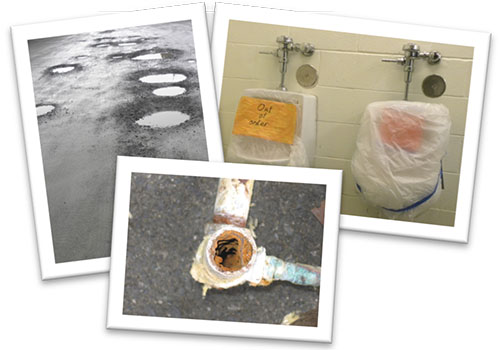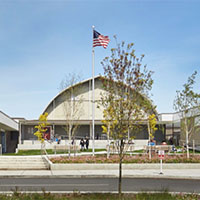— from Maryse Sagewynd —
 A small group tour of Orcas Island school buildings and grounds with Superintendent Eric Webb provided detailed understanding of the school’s critical needs which would be corrected through the financing of the school bond levy. “The public has told us that it wants old infrastructure to be modernized and upgrades to be done well to last a long time, and that the school district should not scrimp to just get by,” Webb told the tour group.
A small group tour of Orcas Island school buildings and grounds with Superintendent Eric Webb provided detailed understanding of the school’s critical needs which would be corrected through the financing of the school bond levy. “The public has told us that it wants old infrastructure to be modernized and upgrades to be done well to last a long time, and that the school district should not scrimp to just get by,” Webb told the tour group.
Mandatory renovations and upgrades to plumbing, sprinkler and heating systems, safety features and crumbling exteriors are some of the most urgent conditions. The high school has corroded iron plumbing pipes – some of which are embedded in concrete floors – failing restroom plumbing and sewer lines, and worn-out, leaking rubber gaskets. Webb discussed the damage caused by the 2014 flooding in the elementary school, making it clear that prevention of further water damage is critical. Roof repair, the fire suppression system and a fire pump are included in the plans, as is the heating system, part of which is failing so that students have to wear coats in their classrooms.
Other safety measures include electronic door openers and upgrading of the school road surface, replacing tile floors and carpeting that are in disrepair, upgrading some wall surfaces to conform to fire code, replacing an exterior boardwalk, and replacing stair coverings and baseboards in the elementary school.
The addition of a new elementary music/multi-purpose room appears to be important for both learning and safety, since the current small music room is half-filled with stored instruments. With the addition of students and their instruments, exiting the crowded conditions could be problematic in case of fire. More elbow room is literally important for both the musicians and their teacher. A new music room, to be added to the current band room building, would free up the current music classroom for other uses.
The Old Gym, heavily used by both pupils and public, has its own safety issues with a slippery floor surface at the end of its lifespan. The old wooden floor, which can no longer be sanded without damage, would be replaced with a fresh wooden floor. The locker rooms, restrooms and equipment would be remodeled and reconfigured and their floors refinished, and the old wooden bleachers and exit doors replaced.
The bond funds would correct deferred maintenance of interiors and exteriors with replacement of some rotten siding and gutter/downspouts, paint, flooring finishes, replacement of wire glass in doors, and restroom improvements. The addition of a vestibule at the high school main entrance will aid in energy conservation, keeping cold air from flooding the commons lobby each time the doors are opened.
The proposed rubberized, permeable-surface track would be fully available to the public for walking, especially helpful for those who need flat surfaces for conditioning and rehabilitation or in wheelchairs. There would be low-level lighting for safety, but not large floodlights. Football games would still be held only in daytime. A low fence surrounding the track would prevent cars from entering.
The plan is to build out the eastern edge of the field enough to accommodate the track and a new grass field for soccer and football. The proposed track builder is Seattle firm D.A. Hogan.
In terms of field maintenance, Webb pointed out that there is already an endowment not being used presently but available for future expenses.
For the long term, Webb said that the school district keeps in mind the overall school grounds complex for future use and expansion, in determining the needs of the students, their schools, and the community.
**If you are reading theOrcasonian for free, thank your fellow islanders. If you would like to support theOrcasonian CLICK HERE to set your modestly-priced, voluntary subscription. Otherwise, no worries; we’re happy to share with you.**









To be clear: the flooding in the Elementary school had nothing to do with failed plumbing pipes. The Flood in the elementary school was caused by improperly stored boxes of documents in a cleaning closet which tipped over and turned on a faucet. The plumbing pipes in the elementary school at the time of the flood were 2 years old.
To also be clear: The afore mentioned endowment for “maintenance” is not a dedicated endowment for maintenance. The money in that fund is unrestricted to the District, and the Board of directors has neither submitted or considered a resolution which would dedicate that money to such purpose.
Yes, many things need repaired at the school, but let’s be sure we are discussing them using facts.
Okay — as someone ACTUALLY on the school board — Justin is correct that the flooding in the Elementary was caused by a freak accident having to do with files and a faucet. And we are grateful for the work that Justin’s company did for the OISD in helping to fix the damage in an incredibly short amount of time, and on budget.
The endowment is another issue. The school board does not need a “resolution” to dedicate money from the generous endowment to the OISD to allocate it to maintenance. The money from the payoff from that endowment will not only be used for maintenance – of the new track/field — but for the new music room (which is never mentioned). The school board is committed to maintaining ALL of our assets.
I think when we discuss facts about the school district — it is best to speak with Eric Webb. Just as when I had questions about a future proposed football field on OIPRD’s long term planning I went to Marcia West. Of course, there is always spin — but when you ask those involved with the matter — there is also accountability.
Janet is correct. There is no need for a resolution. However, if there were a resolution, then the public could be assured that the money was actually going to be focused to that purpose.
I would welcome a side by side conversation sitting with Eric Webb to compare facts and respond to questions. I believe the public should see exactly where the District focus groups and District Staff wanted the money from the bond prioritized. I believe that people should see the current maintenance budgets and facilities maintenance schedules for the buildings they are so heavily invested in. I believe they should read the reports from the Superindentent Athletic Review Comittee cautioning against expanding our athletic programs. I believe they should ask questions, and I believe they should hear from both sides without either side being vilified for conveying their opinions.
I have no intent to spin anything. I do, however, have some very serious concerns, which I have tried to lay out using factual statements about the current bond measure. If, in ANY of the statements I have made there is an untruth, I welcome the scrutiny.
Thank you, Justin and Janet, for clarifying some of these issues. There was some confusion about the unrestricted donation (which, as I understand it, is not actually an “endowment”). Previous commentors on Orcas Issues had suggested that there was money earmarked specifically for maintenance of the track. As Justin and Janet both point out, the school board can use that unrestricted donation however it wishes. The board may, but is not required to, use some of the donation for upkeep on the track, but there is not a dedicated fund for the future of the track. Please correct me if I am misinterpreting your comments.
(Apologies for my ignorance, but has the school board committed to putting part of that unrestricted money towards the cost to build new music room? I hadn’t seen that in the bond statement. If so, great! The music room is a need that I whole-heartedly support.)
Moana- What I have been told by Eric Webb is that the money in question is in an endowment. Here is the direct quote from his communication with me:
“The District is the beneficiary of two endowments. Both are under ownership and management of OICF. Distributions from those funds are made available annually to the District by OICF. Hilary has more specific information on these two endowments. “
Thanks, Justin. “Endowment” is used colloquially to refer to funds whose principle is restricted, with only the interest available to the beneficiary. My understanding, when the original gift was made, was that the principle was available for use as the school board desired. The board may have subsequently chosen to permanently restrict the gift so that they only receive the interest. I don’t know.
Janet, I do believe that the board has the best intentions to keep the track in good shape. However, as evidenced by the many repair and upkeep items in the bond, sometimes those intentions fail when other demands are placed upon resources.
I misunderstood the terms of the original gift to the school. It is a permanently restricted fund from which the district can use only the income, not the principle. I apologize for misspeaking.
Lopez Island School District, with an enrollment of less than half that of Orcas, has had a great track for decades (and has produced a few state champions). They did it with the help of Lopez community donors and local construction companies.